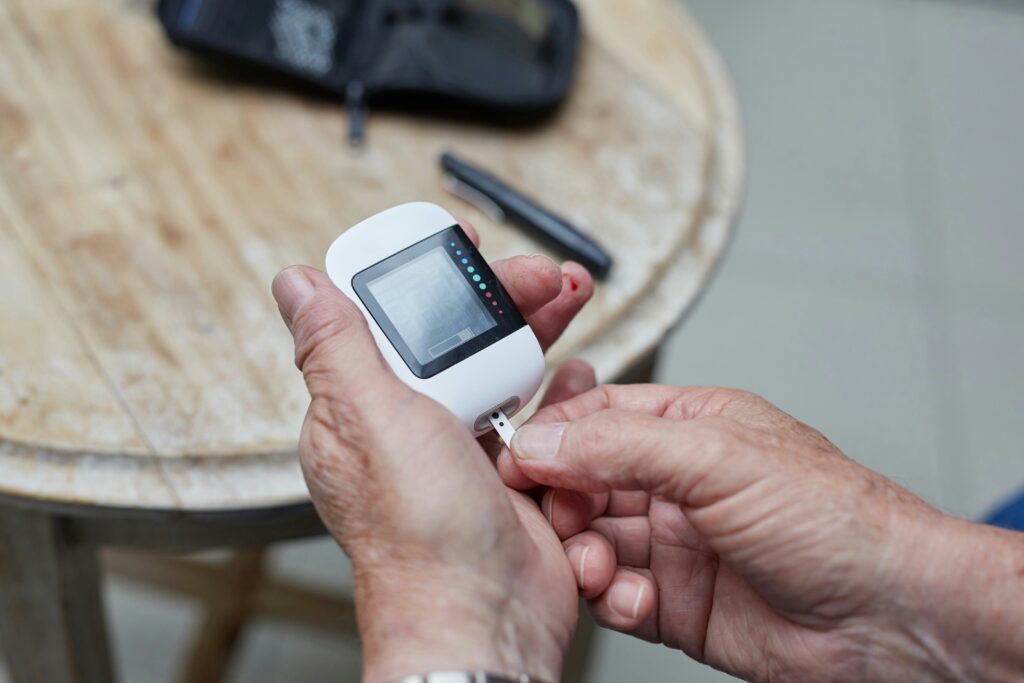The Undiscussed ED Types: ARFID, Diabulimia & Orthorexia
When most people hear about eating disorders, anorexia nervosa and bulimia nervosa often come to mind first. In more recent years, binge eating disorder (BED) has also become better understood. Yet there are other types that remain under the radar: ARFID, diabulimia, and orthorexia. Though each is clinically distinct, they share something in common: insufficient awareness frequently leads to missed diagnoses and delayed treatment. In this article, we’ll take a closer look at what these three lesser-known eating disorders entail, the signs that may indicate they’re present, and why they merit serious attention alongside their more familiar counterparts.
ARFID: Avoidant/Restrictive Food Intake Disorder
What is ARFID?
Avoidant/Restrictive Food Intake Disorder, commonly abbreviated as ARFID, is characterized by a significant limitation in the type or amount of food consumed. Unlike anorexia nervosa, people with ARFID are not driven by a fear of weight gain or a preoccupation with body image. Instead, ARFID often arises from:
- Sensory Sensitivities: Certain tastes, textures, or smells might cause intense aversion.
- Fear of Adverse Consequences: A traumatic experience—like choking or vomiting—can fuel anxiety, leading someone to avoid various foods.
- Low Interest in Eating: Some individuals simply have minimal appetite cues or experience a generalized lack of interest in food.
Why It Matters
Children are often labeled as “picky eaters,” but ARFID goes far beyond routine pickiness. Untreated, it can result in nutritional deficiencies, stunted growth, and social problems—like embarrassment about eating in front of others. Adults with ARFID may struggle to maintain professional or personal engagements that revolve around shared meals.
A key point is that people with ARFID might maintain a “normal” body weight or even be larger-bodied, so it may not be evident that they’re experiencing a restrictive eating disorder. Consequently, they risk misdiagnosis or no diagnosis at all. The emotional burden can be significant; many feel shame or worry that others won’t take them seriously because their disorder isn’t motivated by weight concerns.
Signs & Symptoms
- Extremely limited range of “safe” foods, potentially excluding entire food groups.
- Anxiety, gagging, or panic when presented with certain textures or flavors.
- Reliance on supplements or nutritional shakes for adequate intake.
- Weight loss or growth delays in children, plus possible fatigue or weaker immune response due to malnutrition.

Diabulimia: When Diabetes and Disordered Eating Collide
Defining Diabulimia
“Diabulimia” is not an official diagnostic label in the DSM-5, but it’s frequently used to describe an eating disorder that arises in people with type 1 diabetes who deliberately manipulate their insulin. Insulin therapy is critical for regulating blood glucose. Without proper dosing, the body lacks the means to convert sugar into energy.
Health Consequences
People with diabulimia are at very high risk for severe medical complications, including:
- Diabetic Ketoacidosis (DKA): A potentially life-threatening state of acidosis caused by dangerously high blood glucose and excess ketones.
- Nerve & Organ Damage: Chronic hyperglycemia can damage nerves, kidneys, and eyes.
- Cardiovascular Strain: Irregular insulin usage can put immense stress on the cardiovascular system, raising the risk of heart disease.
Why It Often Goes Undetected
Diabulimia is sometimes overlooked because healthcare providers focus primarily on stabilizing blood sugar rather than exploring why a patient’s insulin adherence is inconsistent. In addition, loved ones may interpret weight loss as a sign of “good control” if the person was previously in a larger body. Meanwhile, the individual with diabulimia might wrestle with guilt and secrecy, aware of the risks but also caught in the fear of weight gain.
Signs & Symptoms
- Fluctuating blood sugar levels with no clear medical explanation.
- Unexplained weight loss, especially if the person is known to have type 1 diabetes.
- Avoidance of doctor visits or inconsistent use of diabetes monitoring tools.
- Persistent thirst, frequent urination, fatigue, or repeated episodes of ketoacidosis.
Recognizing diabulimia is crucial, as early intervention can prevent organ damage and restore safer insulin practices. Typically, treatment involves a coordinated approach among medical professionals, mental health therapists, dietitians, and diabetes educators.

Orthorexia: When “Clean Eating” Goes Too Far
Understanding Orthorexia
Orthorexia nervosa is another unofficial term used to describe an obsessive focus on “healthy,” “clean,” or “pure” foods. The quest for dietary purity may initially appear as a healthy lifestyle change—cutting out processed items, for instance—but in orthorexia, this pursuit becomes rigid, compulsive, and anxiety-inducing.
Core Elements
- Excessive Restriction: An ever-growing list of forbidden foods—often sugar, gluten, dairy, or anything deemed “unhealthy.”
- Judgment Around Food: Individuals may experience intense guilt or shame if they deviate from their self-imposed rules. They might also judge others’ dietary choices, contributing to social isolation.
- Nutritional Deficiencies: Ironically, by restricting so many foods, someone with orthorexia can become malnourished—lacking vital vitamins, minerals, or macronutrients.
Overlaps With Other Disorders
Orthorexia can intersect with anorexia nervosa or bulimia nervosa if weight control also becomes a focus but the hallmark of orthorexia is the fixation on “quality” of food rather than weight or body shape. That said, orthorexia can still escalate into severe physical and psychological consequences, including fear of social situations involving “impure” foods.
Signs & Symptoms
- Spending excessive amounts of time researching diets, reading labels, or preparing specialized meals.
- Anxiety or panic if “clean” foods aren’t available.
- Feelings of moral superiority or intense shame around certain eating choices.
- Physical signs of malnutrition, such as low energy, hair loss, or dry skin, despite an outwardly “healthy” diet.

Why These Are Under-Recognized
Despite increasing awareness, ARFID, diabulimia, and orthorexia often remain overshadowed by other eating disorders. Several factors contribute to their under-recognition:
- Weight-Focused Diagnostic Criteria: Traditional diagnostic frameworks frequently revolve around weight loss or gain. But many with ARFID, orthorexia, or diabulimia may not present with significant weight fluctuations, causing healthcare professionals to overlook the severity.
- Misconceptions About Intent: Because ARFID typically isn’t rooted in body-image distress, family members or providers may not connect the behavior to an eating disorder at all. Similarly, orthorexia can appear as “healthy living,” and diabulimia as “carelessness” in diabetes management.
- Limited Training: Many frontline healthcare providers lack specialized education in lesser-known eating disorder presentations. This gap can cause crucial warning signs to go unnoticed.
The result is that individuals with these conditions can go years without proper diagnosis or support, heightening the risk of physical harm and persistent emotional distress.
Recognizing the Overlaps
Although ARFID, diabulimia, and orthorexia each have unique features, they often share several common threads that overlap with other eating disorders:
- Emotional Turmoil: Fear, anxiety, or guilt are major drivers—whether that’s fear of choking (ARFID), fear of weight gain (diabulimia), or fear of “toxic” foods (orthorexia).
- Life Disruption: Social events, family meals, and day-to-day routines can become sources of stress. Over time, the disorder claims more mental bandwidth, crowding out other hobbies or ambitions.
- High Stakes for Physical Health: Nutritional deficiencies, metabolic disturbances, or, in the case of diabulimia, acute medical crises can lead to hospitalization or long-term complications.

Pathways to Recovery
Professional Assessment
If you suspect that you or someone close to you might have ARFID, diabulimia, or orthorexia, the first step is to seek a thorough evaluation. This often involves a multidisciplinary team—therapists, dietitians, and possibly medical specialists (such as endocrinologists for diabulimia or pediatricians for ARFID in children). A comprehensive assessment can rule out other medical causes and clarify the nature of disordered eating behaviors.
Tailored Interventions
- ARFID: Treatment might include gradual exposure therapy to manage sensory sensitivities or fear-based avoidance. Occupational therapy can help with tactile or taste aversions, while cognitive-behavioral strategies address underlying anxiety.
- Diabulimia: A specialized approach often involves medical monitoring to stabilize blood sugar, combined with psychotherapy to address body image, stress coping, and the complex relationship with insulin. Family therapy or support groups can also be critical.
- Orthorexia: Cognitive-behavioral therapy (CBT) can challenge black-and-white thinking around food purity. Nutritional counseling helps reintroduce previously “forbidden” foods, while exposure to less controlled eating situations is key to overcoming rigid fears.
Education & Support
Family education is pivotal, as loved ones play an instrumental role in identifying disordered behaviors and providing ongoing support. Regular check-ins with healthcare providers can help track both psychological progress and physical health—particularly for diabulimia, where blood glucose management is vital.
Breaking the Silence
Society’s narrow view of eating disorders can inadvertently leave some individuals feeling confused or invalidated. Yet ARFID, diabulimia, and orthorexia are real and often severe—impacting quality of life, relationships, and long-term health outcomes. Public awareness is slowly improving, but destigmatizing these disorders starts with sharing information and encouraging people to speak openly about their experiences.
If a friend suddenly refuses entire categories of foods because they “feel unsafe,” don’t dismiss them as “just picky.” If a loved one with diabetes is manipulating insulin doses, it may be more than forgetfulness. Recognizing these signs and urging professional help can be life-changing.
A Call for Compassionate Awareness
All eating disorders, including the less-discussed ones, are serious conditions requiring empathy and evidence-based care. Breaking free from an eating disorder isn’t just about changing eating behaviors; it involves dismantling harmful thought patterns and reestablishing a sense of safety and balance around food and one’s body. By raising awareness of ARFID, diabulimia, and orthorexia, we can foster a more inclusive understanding of disordered eating and ensure that more people receive the help they need—no matter how their symptoms present.
Remedy Therapy Center for Eating Disorders is a privately owned, high-touch facility in Florida providing evidence-based, compassionate care for individuals facing anorexia, bulimia, binge eating disorder, ARFID, and more. If you or a loved one is seeking support, we’re here to help. You don’t have to face recovery alone—hope is here.
